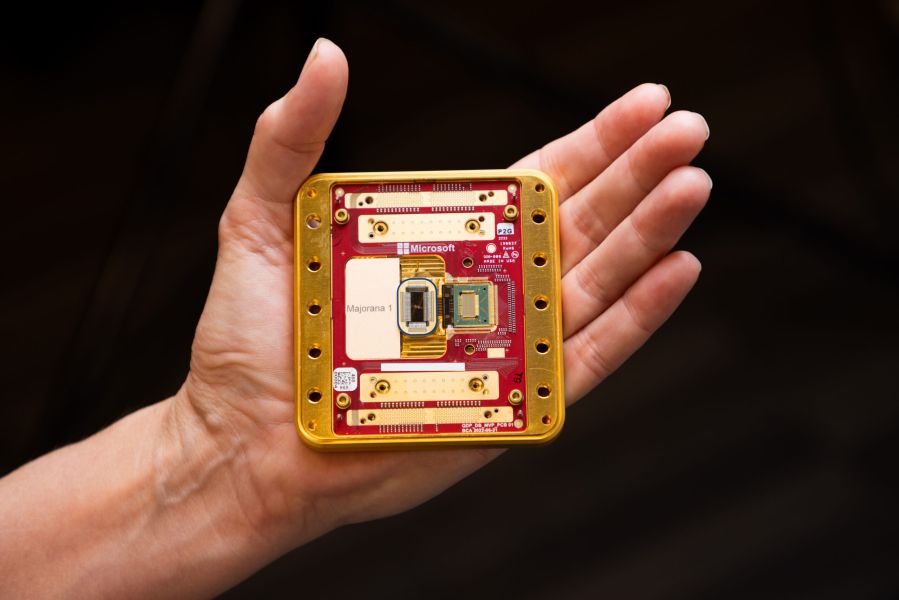Microsoft introduces Majorana 1, a pioneering quantum chip utilising topological qubits powered by topoconductors. It achieves digital control and scalability towards one million qubits, integrating with AI, HPC and classical systems to solve industrial-scale problems, marking a significant stride towards commercially viable quantum computing.

Microsoft introduces its Majorana 1 quantum chip, a breakthrough powered by a new Topological Core architecture that promises to advance quantum computing for solving meaningful, industrial-scale problems in years rather than decades. This pioneering chip uses the world’s first topoconductor—a specially engineered topological superconductor—to create and control Majorana particles that form robust, scalable qubits.
Majorana 1 represents a significant departure from traditional approaches. Designed to hold eight topological qubits on a chip that fits in the palm of one’s hand, it provides a clear, scalable path towards constructing a quantum computer with a million qubits.
The chip integrates both qubits and surrounding control electronics and is built to operate within an ecosystem of control logic, dilution refrigeration (maintaining temperatures far below outer space) and a software stack that links with AI and classical computing systems in Azure data centres.
Markus Pflitsch, founder and CEO of Terra Quantum, comments:
“This is truly an advance for the industry: building a custom chip that uses topological qubits which many consider extremely useful for scaling to powerful quantum computers. The announcement reinforces our assessment that fault-tolerant quantum hardware is closer than many business leaders think.
However, we agree with Microsoft that a hybrid solution of AI, HPC and quantum will deliver commercial value before the arrival of universal, fault-tolerant quantum systems. That’s why we continue to focus on hybrid hardware architectures that combine the strengths of classical and quantum computing to provide a competitive edge now.”
Innovative materials and a digital measurement approach
At the heart of the Majorana 1 is a breakthrough materials stack developed by Microsoft researchers. By utilising indium arsenide combined with aluminium, the team creates a topoconductor that not only supports the emergence of exotic Majorana particles but also ensures that qubits remain small, fast, and digitally controllable. In a manner reminiscent of inventing the transistor for the quantum age, Microsoft’s approach focuses on both quality and the precise arrangement of atoms.
“We took a step back and said ‘OK, let’s invent the transistor for the quantum age. What properties does it need to have?” explains Chetan Nayak, Microsoft technical fellow.
The new chip also features a measurement technique that uses voltage pulses—comparable to flicking a light switch—to detect qubit states. This digital control replaces the need for fine-tuned analogue controls and is capable of detecting minute differences, such as between one billion and one billion and one electrons in a superconducting wire.
Scalability and the quest for a million qubits
Microsoft’s design is purposefully engineered for scalability. Each “H”-shaped configuration of aluminium nanowires on the chip hosts four controllable Majoranas, forming a single qubit. These “tiles” can be arranged systematically to build larger, more complex quantum processors.
“Whatever you’re doing in the quantum space needs to have a path to a million qubits. If it doesn’t, you’re going to hit a wall before you get to the scale at which you can solve the really important problems that motivate us,” Nayak adds.
The robust, error-resistant design of the topological qubit not only minimises the need for extensive error correction but also opens up the possibility of running trillions of fast, reliable operations—essential for tackling challenges that current classical computers cannot solve.
Collaborative progress and future commercial impact
The Majorana 1 chip is a key element in Microsoft’s broader ambition to deliver commercially relevant quantum hardware. In addition to developing its own quantum solutions, Microsoft partners with firms such as Quantinuum and Atom Computing to push the boundaries of current qubit technology.
Its inclusion in the final phase of DARPA’s Underexplored Systems for Utility-Scale Quantum Computing (US2QC) programme further underscores the strategic importance of the Majorana 1.
Microsoft’s vision extends beyond hardware. By integrating quantum computing with high-performance computing (HPC) and AI, the company aims to deliver commercial value well before universal, fault-tolerant quantum systems become commonplace.
As Matthias Troyer, Microsoft technical fellow, states:
“From the start we wanted to make a quantum computer for commercial impact, not just thought leadership. We knew we needed a new qubit. We knew we had to scale.”
The potential applications of a million-qubit quantum computer are far reaching. From breaking down microplastics into harmless byproducts and designing self-healing materials, to refining chemical processes and enhancing catalyst design for environmental and industrial benefit, quantum computing promises to transform sectors that rely on precision modelling of nature’s complexities.
Troyer further adds:
“Any company that makes anything could just design it perfectly the first time out. It would just give you the answer. The quantum computer teaches the AI the language of nature so the AI can just tell you the recipe for what you want to make.”
Krysta Svore, Microsoft technical fellow, summarises the architectural advantages:
“It’s complex in that we had to show a new state of matter to get there, but after that, it’s fairly simple. It tiles out. You have this much simpler architecture that promises a much faster path to scale.”
As Microsoft continues to refine its processes and integrate the multiple components of quantum computing technology, Majorana 1 not only validates its early commitment to topological qubits but also signals a promising future where scalable, fault-tolerant quantum systems become a commercial reality.

Himani Verma is a seasoned content writer and SEO expert, with experience in digital media. She has held various senior writing positions at enterprises like CloudTDMS (Synthetic Data Factory), Barrownz Group, and ATZA. Himani has also been Editorial Writer at Hindustan Time, a leading Indian English language news platform. She excels in content creation, proofreading, and editing, ensuring that every piece is polished and impactful. Her expertise in crafting SEO-friendly content for multiple verticals of businesses, including technology, healthcare, finance, sports, innovation, and more.











